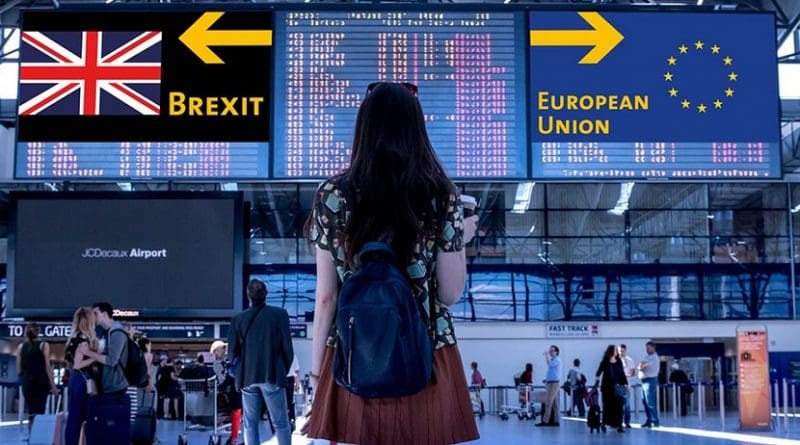Could Canada-Style Deal Provide A Brexit Breakthrough? – OpEd
By Arab News
By Andrew Hammond*
With the UK about to choose its next prime minister, the Brexit issue at the heart of the debate reared its head in far-off Montreal this week at the EU-Canada summit. Center stage in that discussion was the landmark bilateral trade agreement that many Brexiteers believe is the best template for a future EU-UK deal, despite the plethora of pitfalls it would have for London.
The so-called Comprehensive Economic and Trade Agreement (CETA), covering about a fifth of the global economy, took the best part of a decade to negotiate and was signed in October 2016. It saw 98 percent of all tariffs on goods traded between the two powers become duty free, and has been billed as “the most ambitious trade agreement the EU has ever concluded.”
Most tariffs were removed when the deal came provisionally into force in 2017, with the key remaining step being full ratification, which could potentially take several more years.
The EU has negotiated a wide range of external trade agreements for member states, but for many Brexiteers it is the “Canada model” that stands out. Part of the reason for this is that, in their eyes, it would allow the UK to completely leave the Brussels-based club, including the customs union and single market, and allow London to do free trade deals with other countries.
However, despite the glorification of CETA by many Brexiteers, it would come with significant costs for the UK given the different starting positions of Ottawa and London, with the latter a member of the EU for more than four decades and embedded into many of its structures. Whereas CETA represents a net level of integration between the EU and Canadian economies, a similar deal would represent a sharp break (or “hard Brexit”) between the UK and EU.
Moreover, CETA does little to enable some key business sectors. Take the example of financial services — a huge part of the UK economy — which sees neither Canadian nor EU firms getting so-called “passporting” rights to allow their firms to sell their products in each other’s markets. CETA also does not eliminate border controls, although it does incentivize the use of advanced electronic checking to expedite customs clearance.
A further potential challenge comes with the fact that a Canada-style deal would end the UK’s preferential access to more than 50 markets outside Europe with which the EU has trade agreements. While there would be the opportunity to renegotiate these bilaterally, there are no guarantees that London would obtain terms as good as those they have today, despite what Brexiteers say, as current UK-Japanese trade discussions indicate.
While Brexiteers also suggest that negotiating a Canada-style deal would be relatively easy, this belies the challenges involved. Indeed, in 2016, after about seven years of discussions, there was a near-complete collapse of CETA talks. This came when the legislature in Wallonia — a region of Belgium with a population of about 3.5 million — indicated to Canada that its opposition to key provisions of the proposed deal were “red lines.”
What this exemplifies, on both the economic and political fronts, is that all of the various alternative models to the UK’s membership of the EU — from no deal to a harder Brexit like Canada or a softer Brexit like Norway — all involve key trade-offs. And this is why the UK government has, since the Brexit referendum in 2016, found it so very hard to find a single alternative model that can secure consent from other key parties and comes close to providing the same balance of influence and advantages that London gets from its current status inside the 28-member union.
For instance, London has all the benefits of the single market’s economic powerhouse but is not part of the euro zone, it has retained a budgetary rebate, and ensured it cannot be outvoted by euro zone countries against its interests. It is also not a part of the Schengen border-free area, which means it operates border controls with other EU member states.
The stark reality is that, while the nature of bilateral agreements with the EU vary, all have key disadvantages, including none having full access to services (such as the financial sector), which account for 80 percent of the UK economy. This is true even of Norway, a “softer Brexit” at the opposite pole to Canada, which would provide considerable continued access to the single market.
While the Norway model is widely championed in the UK, including by former Remainers, it has other key drawbacks. For instance, in exchange for access to the single market, Oslo is a “rule taker” rather than a “rule maker,” requiring it to adhere to EU rules without having a vote on them. It must also accept free movement of people, make contributions to EU programs and budgets, and do customs checks on goods crossing into the EU.
Taken overall, while CETA contains many benefits for the EU and Canada, the balance of advantages and disadvantages would be very different for the UK. For all the EU’s flaws, London currently enjoys a uniquely positive position in what is the world’s largest political and economic union, and continued membership of a reformed EU would be a better option for the nation.
- Andrew Hammond is an Associate at LSE IDEAS at the London School of Economics

